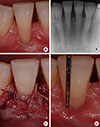1. Albandar JM, Kingman A. Gingival recession, gingival bleeding, and dental calculus in adults 30 years of age and older in the United States, 1988-1994. J Periodontol. 1999; 70:30–43.

2. Wennström JL. Mucogingival therapy. Ann Periodontol. 1996; 1:671–701.

3. Oates TW, Robinson M, Gunsolley JC. Surgical therapies for the treatment of gingival recession: a systematic review. Ann Periodontol. 2003; 8:303–320.

4. Cairo F, Nieri M, Pagliaro U. Efficacy of periodontal plastic surgery procedures in the treatment of localized facial gingival recessions: a systematic review. J Clin Periodontol. 2014; 41:Suppl 15. S44–S62.

5. Harvey PM. Management of advanced periodontitis. I. Preliminary report of a method of surgical reconstruction. N Z Dent J. 1965; 61:180–187.
6. Grupe HE, Warren RF Jr. Repair of gingival defects by a sliding flap operation. J Periodontol. 1956; 27:92–95.

7. Nelson SW. The subpedicle connective tissue graft: a bilaminar reconstructive procedure for the coverage of denuded root surfaces. J Periodontol. 1987; 58:95–102.
8. Borghetti A, Louise F. Controlled clinical evaluation of the subpedicle connective tissue graft for the coverage of gingival recession. J Periodontol. 1994; 65:1107–1112.

9. Smukler H. Laterally positioned mucoperiosteal pedicle grafts in the treatment of denuded roots: a clinical and statistical study. J Periodontol. 1976; 47:590–595.

10. Caffesse RG, Guinard EA. Treatment of localized gingival recessions. Part IV. Results after three years. J Periodontol. 1980; 51:167–170.

11. Caffesse RG, Alspach SR, Morrison EC, Burgett FG. Lateral sliding flaps with and without citric acid. Int J Periodontics Restorative Dent. 1987; 7:42–57.
12. Zucchelli G, Cesari C, Amore C, Montebugnoli L, De Sanctis M. Laterally moved, coronally advanced flap: a modified surgical approach for isolated recession-type defects. J Periodontol. 2004; 75:1734–1741.

13. Santana RB, Furtado MB, Mattos CM, de Mello Fonseca E, Dibart S. Clinical evaluation of single-stage advanced versus rotated flaps in the treatment of gingival recessions. J Periodontol. 2010; 81:485–492.

14. Miller PD Jr. A classification of marginal tissue recession. Int J Periodontics Restorative Dent. 1985; 5:8–13.
15. Cairo F, Cortellini P, Tonetti M, Nieri M, Mervelt J, Cincinelli S, et al. Coronally advanced flap with and without connective tissue graft for the treatment of single maxillary gingival recession with loss of inter-dental attachment. A randomized controlled clinical trial. J Clin Periodontol. 2012; 39:760–768.

16. Miller SC. Textbook of periodontia. Philadelphia: Blakiston Co.;1938.
17. Allen AL. Use of the supraperiosteal envelope in soft tissue grafting for root coverage. II. Clinical results. Int J Periodontics Restorative Dent. 1994; 14:302–315.
18. Ricci G, Silvestri M, Rasperini G, Cattaneo V. Root coverage: a clinical/statistical comparison between subpedicle connective tissue graft and laterally positioned full thickness flaps. J Esthet Dent. 1996; 8:66–73.

19. Han JS, John V, Blanchard SB, Kowolik MJ, Eckert GJ. Changes in gingival dimensions following connective tissue grafts for root coverage: comparison of two procedures. J Periodontol. 2008; 79:1346–1354.

20. Bouchard P, Malet J, Borghetti A. Decision-making in aesthetics: root coverage revisited. Periodontol 2000. 2001; 27:97–120.

21. Langer B, Langer L. Subepithelial connective tissue graft technique for root coverage. J Periodontol. 1985; 56:715–720.

22. Gordon HP, Sullivan HC, Atkins JH. Free autogenous gingival grafts. II. Supplemental findings: histology of the graft site. Periodontics. 1968; 6:130–133.
23. Esteibar JR, Zorzano LA, Cundin EE, Blanco JD, Medina JR. Complete root coverage of Miller Class III recessions. Int J Periodontics Restorative Dent. 2011; 31:e1–e7.
24. Chambrone LA, Chambrone L. Treatment of Miller class I and II localized recession defects using laterally positioned flaps: a 24-month study. Am J Dent. 2009; 22:339–344.
25. Zucchelli G, Marzadori M, Mele M, Stefanini M, Montebugnoli L. Root coverage in molar teeth: a comparative controlled randomized clinical trial. J Clin Periodontol. 2012; 39:1082–1088.

26. Yilmaz E, Ozcelik O, Comert M, Ozturan S, Seydaoglu G, Teughels W, et al. Laser-assisted laterally positioned flap operation: a randomized controlled clinical trial. Photomed Laser Surg. 2014; 32:67–74.











 PDF
PDF ePub
ePub Citation
Citation Print
Print




 XML Download
XML Download